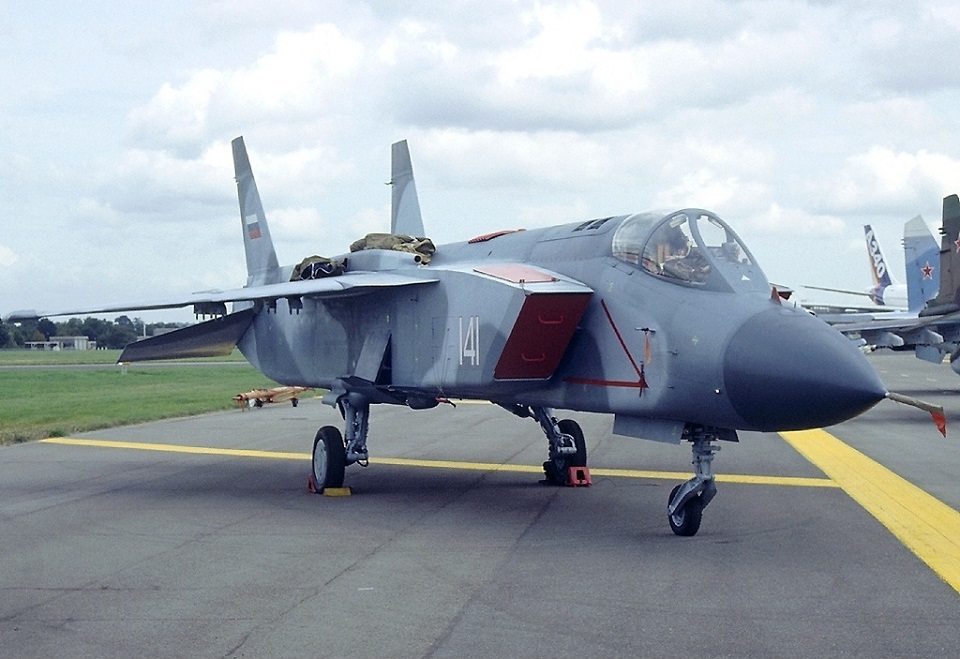Defence
Russia Plans to develop 5th and 6th Generation VTOL Fighters

Recent reports from the Russian website TopWar.ru reveal that a division of the United Aircraft Corporation (UAC), in collaboration with Rostec, is exploring the development of a new generation of vertical takeoff and landing (VTOL) fighters.
Although details about the aircraft’s specific applications remain limited, the prospect of VTOL technology is particularly promising for its potential use on aircraft carriers and amphibious assault ships—environments where such capabilities are highly valued.
Yakovlev, a key player in Russian aircraft design, is contemplating a revival of the Yak-141, the world’s first supersonic VTOL aircraft, which first took to the skies in 1987. The Yak-141, an evolution of the Yak-36 design from the 1950s, could form the basis for Russia’s next-generation VTOL fighter.
Russian Airlines Are Still Getting American Parts Despite Sanctions:Click here
Given the challenges currently faced by Russia’s air force, particularly in the context of the ongoing conflict in Ukraine, there is a strong push to develop a new, advanced fighter jet by 2050. However, experts express skepticism about this timeline, citing ongoing difficulties with Russia’s current generation of stealth fighters.
Developing a new fighter jet is an intricate and costly endeavor. Even with substantial investments in research and development, as well as potential construction of new aircraft carriers, the production of these advanced jets is expected to be limited. The complexities involved in designing and manufacturing a VTOL aircraft include miniaturizing and advancing avionics, creating a specialized airframe and wing, and most critically, developing a powerful and reliable engine.
Why are Russian fighter jets ten times cheaper than American fighter jets?:Click here
On July 27, 2024, Andrey Boginsky, head of Yakovlev, confirmed the company’s readiness to resume VTOL development. He emphasized Yakovlev’s extensive experience in the field, noting that the design bureau has been working on VTOL aircraft since the late 1950s, with notable achievements such as the Yak-38 and Yak-141.
Boginsky highlighted that leveraging both new aviation technologies and the preserved technical knowledge from the 1990s could facilitate a swift return to VTOL aircraft development, russia commercial aircraft provided the Ministry of Defense assigns the project.
The potential benefits of VTOL aircraft extend beyond naval applications; they could also play a critical role for the Aerospace Forces, particularly in scenarios where base airfields are vulnerable to missile and bomb attacks. These aircraft could be deployed on various types of ships and land-based sites without the need for traditional runways, making them highly versatile.

Defence
Russia’s NV.17 Hybrid Helicopter Aims to Balance Light and Heavy Helicopter Needs

As Western sanctions continue to impact Russia’s aviation sector, the country is making significant strides in advancing its domestic aerospace capabilities.
Despite the ongoing challenges, Russia has unveiled the Heliburo HB.17, a cutting-edge hybrid-powered medium-class helicopter that promises to reshape both commercial and military aviation.
The helicopter is currently in the technical design phase, with plans for its first flight slated for 2027. This marks a major step forward in Russia’s efforts to modernize its aviation fleet and reduce reliance on foreign technology.
This country tops visa rejections in the popular Schengen countries
The HB.17 is designed as a versatile, multi-role aircraft, capable of performing a wide range of functions. It is built to handle cargo transport, passenger carriage, reconnaissance, and close air support missions. With its robust design and flexible capabilities, the HB.17 is expected to meet the needs of both military and commercial operators, offering a solution for missions requiring a greater capacity than light helicopters but avoiding the limitations of larger aircraft.
One of the most innovative features of the HB.17 is its hybrid power plant. This combination of conventional and electric technologies enhances fuel efficiency, allowing the helicopter to stay airborne for up to seven hours without needing to refuel.
This extended operational endurance makes the HB.17 particularly well-suited for long-duration missions, providing a significant advantage over traditional helicopters. Additionally, the HB.17 will be equipped with modern avionics, ensuring advanced navigation, communication, and operational capabilities.
Qatar Airways Cargo and MASkargo Launch New Strategic Partnership
The HB.17 is positioned to compete with other medium-class helicopters such as the Kamov Ka-60/62 and the Mil Mi-38. However, its hybrid powerplant and modern avionics set it apart, offering a more efficient and technologically advanced alternative.
Its multi-role versatility, combined with its fuel efficiency and cutting-edge systems, gives it a competitive edge in the evolving aviation landscape. The introduction of the HB.17 follows recent reports of Russia receiving a new batch of armored vehicles from the UAE-based Streit Group.
Russia has traditionally focused on producing helicopters for defense purposes, but this time, it appears to be venturing into the civilian helicopter market with the HB.17.
This, along with the ongoing development of the HB.17, reflects Russia’s continued efforts to modernize its military assets and increase its self-reliance, even as sanctions continue to pressure its defense and aerospace sectors.
As Russia faces mounting geopolitical challenges, the HB.17 stands as a symbol of resilience, technological innovation, and determination to maintain its military and aviation capabilities.
-

 Aviation2 months ago
Aviation2 months agoMicrosoft Flight Simulator Raises $3 Million to Bring Back the An-225 Mriya
-

 Airlines2 months ago
Airlines2 months agoQatar Citizens Can Travel to the United States Without a Visa
-

 Aviation2 months ago
Aviation2 months agoQatar Airways bans these new Electronic Devices on plane
-

 Airlines2 months ago
Airlines2 months agoJapan Airlines Rolls Out Free Domestic Flights to International Passengers
-

 Defence2 months ago
Defence2 months agoWhich Country Has the Largest Fleet of Fighter Aircraft?
-

 Airport2 months ago
Airport2 months agoWestern Sydney Airport Welcomes Its First Plane After 6 Years of construction
-

 Airlines4 days ago
Airlines4 days agoDAMAC Air: Dubai’s New Luxury Airline Offers Free Flights for Registration
-

 Aviation2 months ago
Aviation2 months agoDid you know ? Once Boeing 747 carried 1088 passenger in 1991








